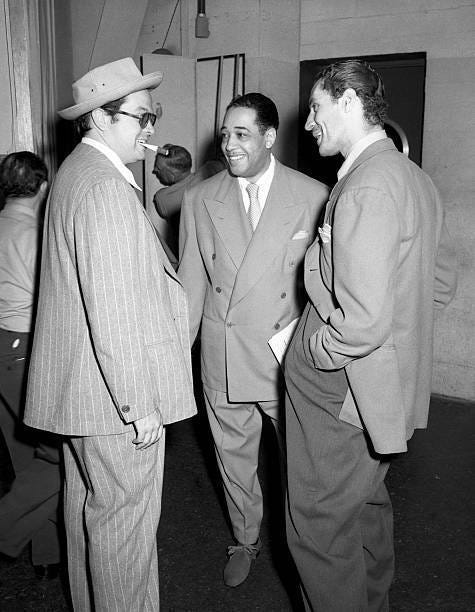Last time, we heard the first 20 minutes of this conversation. (See the Index.) Duke began by telling that Orson Welles paid him to write a musical history of jazz, but Welles never made the planned film, It's All True. We saw a magazine photo of the two men plus singer Herb Jeffries,. Here is a rare one from the same 1941 photo shoot, through the courtesy of Steven Lasker:
Now, back to 1955 and the taped conversation. Evidently, the meeting took place at the Feathers’ apartment on 106th Street. Duke lived further north, near 157th Street, but he owned two buildings on Riverside Drive, around the corner from Feather. Duke’s sister Ruth lived at 333 Riverside Drive and Tempo Music was based there as well. After 1942, most of Duke’s music was published by Tempo, of which Ruth was president and 90% owner. Mercer lived next door at 334. For these and other reasons, 106th Street is now known as Duke Ellington Boulevard. Duke himself was said to have moved to 333 in 1961, but he appears to have primarily lived elsewhere, first near 100th Street, and then near Lincoln Center in his final years.
This section of the recording begins with Feather asking Ellington whether he thinks the fact that the younger artists have more musical education is good for jazz. This is a debate that continues to this day, of course.
Jane, Leonard’s wife, had already said goodnight but she comes back in at 1:24 to offer Duke a piece of cake. He declines, saying that he already had dinner and pie because he had to go to the doctor and Evie, his long-time companion, or "mistress," as they used to say, was starving. Jane asks where they ate and it sounds as though he says "Stage," which could mean the legendary Stage Deli near West 54th Street.
A few more notes: At 2:20, "the old masters” was Ellington's way of referring to classical composers such as Beethoven. It's interesting at 3:48 to hear Feather state that there had been a tremendous increase in the acceptance of jazz. But Duke notes that jazz still “scares people away” who are afraid that they won’t know what’s going on and will come off as “squares.” He mentions at 5:25 that he had met the accomplished violinist Henri Temianka, who said that modern classical music had the same problem of scaring people away. Of course these comments are still valid today.
And at 6:52, Duke signals the end of the interview by launching into his “official” endorsement, which Feather's publisher can use to promote the book.
Listen, and Enjoy!
All the best,
Lewis
Playback with Lewis Porter! is a reader-supported publication. To receive new posts and support my work, consider becoming a free or paid subscriber. Paid subscribers at $5/month or $50/yr get extra content and heartfelt thanks! For any amount over $50/yr, Founding Members will meet with Lew on Zoom, have access to rare ebooks and audio, etc.!




It is interesting to hear Duke make those points, albeit in an unusually hesitating way.
Did anyone ever ask Duke about the recordings he made in the early 30s with studio singers like Chick Bullock, Dick Robertson and Smith Ballew? I don't mean because they were white, but because of the materal the band had to play, and whether the material was thrust upon them--I assume it was.
In the case of "Sam & Delihah" with Bullock, it seems to have been a unique performance in that Bullock was heavily featured, a rarity, even amongst Duke's famous singers, who were yet to come.
Is it true that audiences at live performances wanted to hear "S&D", but Duke wouldn't perform it without Bullock?
Julian Vein
It seems I cannot play the audio. I can still play the audio from the previous post. Is there something wrong with the upload?